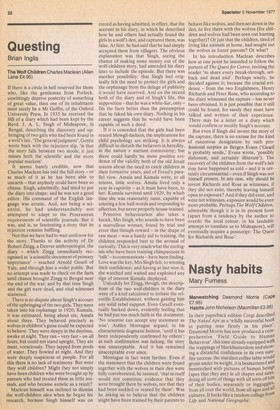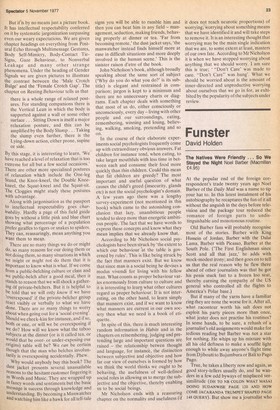Nasty habits
Mary Furness
Manwatching Desmond Morris (cape £7.95) Habits John Nicholson (Macmillan £3.95) In their paperback edition Corgi described The Naked Ape as a `wildly successful book at putting man firmly in his place'. Desmond Morris has now produced a corn.. prchensive 'Field Guide to Human Behaviour', this time already equipped with the trappings of blockbusterdom and showing a distateful confidence in its own surefire success: the sturdiest coffee table would groan under its weight, it is besmattered and besmirched with pictures of human beings (apes that they are) in all shapes and sizes, doing all sorts of things with all sorts of bits of their bodies, separately or inggaggles, from all over the world, from all ages and all cultures. It looks like a random collage front Life and National Geographic. But ieis by no means just a picture book. It has intellectual respectability conferred on it by systematic jargonization surpassing even our weary expectations. We are given chapter headings on everything from Postural Echo through Multimessage Gestures, Body Self-Mimicry, Body-Contact TieSigns, Gaze Behaviour, to Nonverbal Leakage and many other strange phenomena. Under the heading of Gender Signals we are given pictures to illustrate the contrast between the 'Male Crotch Bulge' and the 'Female Crotch Gap'. The chapter on Resting,Behaviour tells us that there is a whole range of relaxed postures. For standing companions there is the Vertical Lean in which the body is supported against a wall or some other surface. . . Sitting Down is itself a major relaxation posture, and this can be amplified by the Body Slump Taking the slump even further, there is the Lying-down action, either prone, supine or side.
By this stage, it is interesting to learn, 'We have reached a level of relaxation that is too extreme for all but a few social occasions.' There are other more specialised postures of relaxation which include the One-leg Stand, the Knee-kneel, the Double Kneekneel, the Squat-kneel and the Squat-sit. The Cloggies might study these postures With advantage.
Along with jargonisation as the passport to intellectual respectability goes charteability. Hardly a page of this field guide goes by without a little pink and blue chart Showing what percentage of a population Prefer giraffes to tigers or snakes to spiders. They can, reassuringly, mean anything you want them to mean.
There are so many things we do or might do, so many reasons for our doing them or not doing them, so many situations in which !ve might or might not do them that it is trnportant to know what is what. If we come from a public-belching culture or class and We public-belch after a good meal, then it !tands to reason that we will shock a gatherlag of private-belchers. But it is helpful to be told that we will only know if we have overexposed' if the private-belcher group react visibly or Verbally to what we have done. There are so many things to worry about when going out for a 'social evening'. Should we cheek-kiss for instance, and if so, both or one, or will we be overexposing if We do? How will we know what the taboo subjects at the dinner (or is it called tea, or would that be overor under-exposing our origins) table will be? We can be certain though that the man who belches involuntarily is overexposing accidentally. Phew.
Why would anybody buy this book? The dust jacket presents several unassailable reasons to the hesitant customer fingering it in Words and Music. They are wrapped up in fancy words and sentiments but the basic Message is success through knowledge and understanding. By becoming a Manwatcher and watching him like a hawk for all tell-talc signs you will be able to rumble him and then you can beat him in any field — management, seduction, making friends, behaving properly at dinner or tea. 'Far from becoming remote,' the dust jacket says, 'the manwatcher instead finds himself more at ease in difficult situations and more deeply involved in the human scene.' This is the sinister raison d'etre of the book.
John Nicholson's book, although broadly speaking about the same sort of subject ('Why do you do what you do?' is its subtitle) is elegant and restrained in comparison; jargon is kept to a minimum and there are no unnecessary charts or diagrams. Each chapter deals with something that most of us do, either consciously or unconsciously, every day — living with other people and our surroundings, eating, remembering, winning and losing, believing, walking, smoking, pretending and so on.
In the course of their elaborate experiments social psychologists frequently come up with extraordinary obvious answers. Fat children for instance tend, when eating, to take larger mouthfuls with less time in between each and consume their food more quickly than thin children. Could this mean that fat children are greedy? The most important and useful. question of what causes the child's greed (insecurity, glands etc) is not the social psychologist's domain. A few years ago there was a lengthy survey-experiment (not mentioned in this book) which came to the astonishing conclusion that lazy, unambitious people tended to sleep more than energetic ambitious people. The fact that we have words to express these concepts and know what they mean implies that we already know that.
According to Mr Nicholson social psychologists have been struck by 'the extent to which our behaviour 'at the table is governed by rules'. This is like being struck by the fact that manners exist. But we know that since man is a social being he devises a modus vivendi for living with his fellow man. What counts as proper behaviour varies enormously from culture to culture and it is interesting to learn, what other cultures regard as proper behaviour. It is not interesting, on the other hand, to learn simply that manners exist, and if we want to know what manners are current in our own society then what we need is a book of etiquette.
In spite of this, there is much interesting random information in Habits and in the chapters on remembering, judging and pretending large and important questions are raised — the relationship betwen thought and language, for instance, the distinction between subjective and objective and how far our view of ourselves is formed by how we think the world thinks we ought to be behaving, the usefulness of well-defined social roles in allowing us to merge the subjective and the objective, thereby enabling us to be social beings.
Mr Nicholson ends with a reassuring chapter on the normality and usefulness (if it does not reach neurotic proportions) of worrying; worrying about something means that we have identified it and will take steps to remove it. It is an interesting thought that worrying may be the main single indication that we are, to some extent at least, masters of our own fate. According to Mr Nicholson it is when we have stopped worrying about anything that we should worry. I am sure this is true; "Don't Care' was made to care. "Don't Care" was hung'. What we should be worried about is the amount of inner-directed and unproductive worrying about ourselves that we go in for, as exhibited by the popularity of the subjects under review.



































 Previous page
Previous page